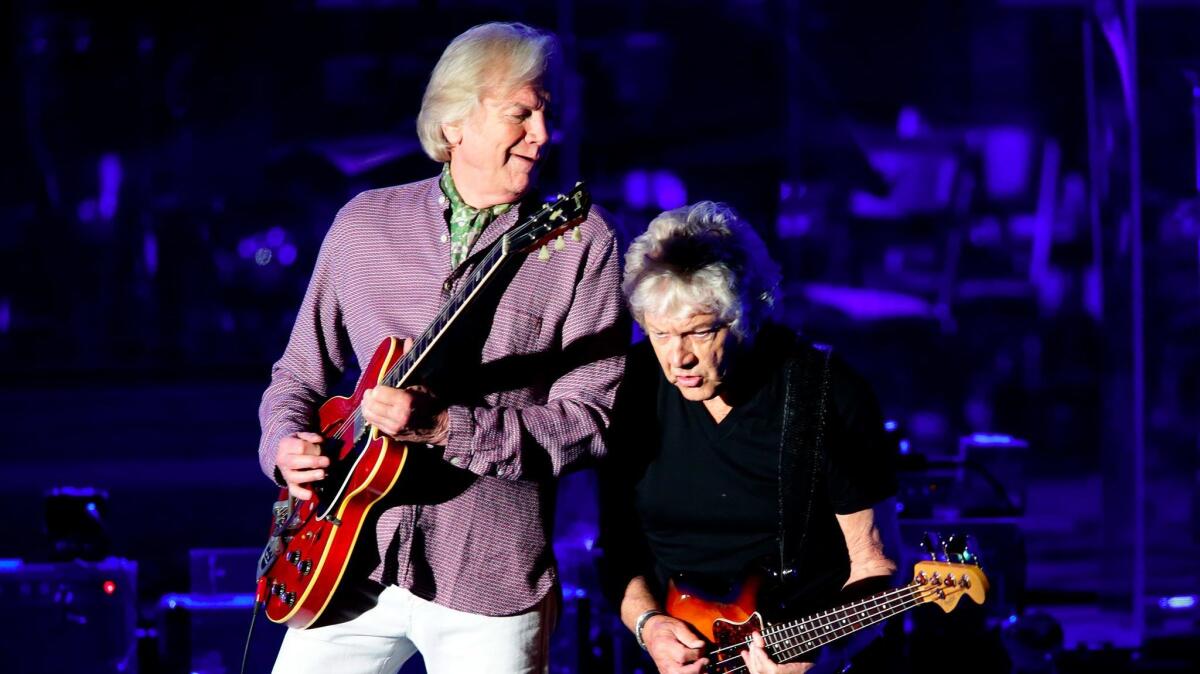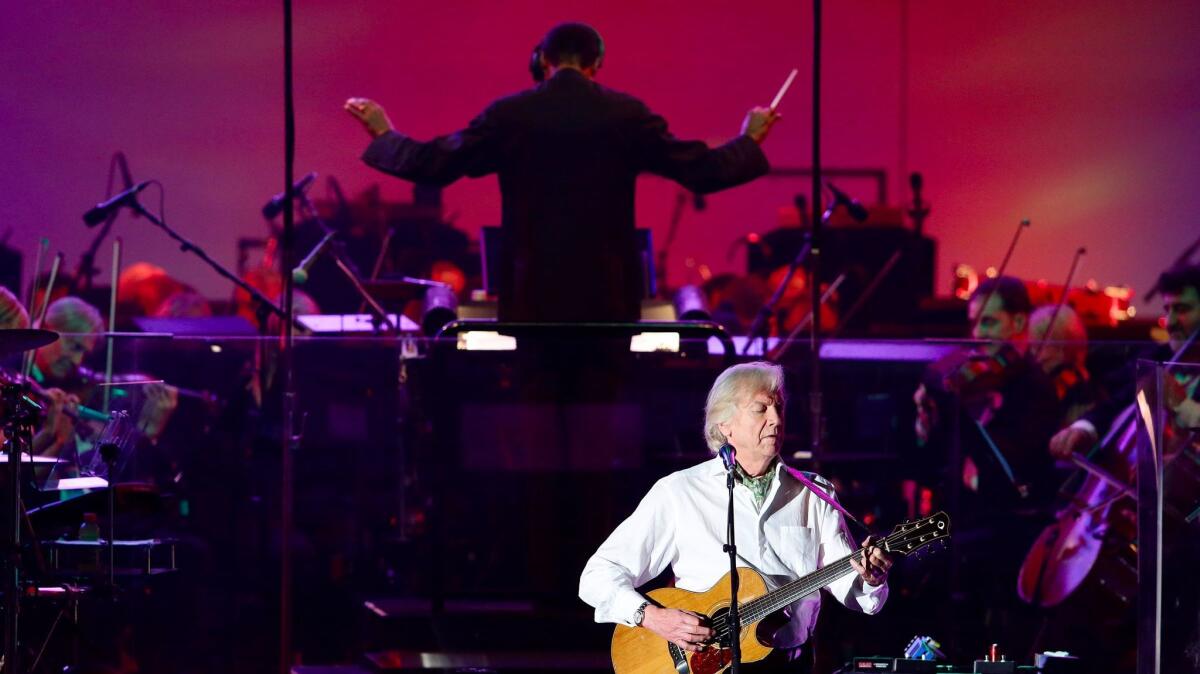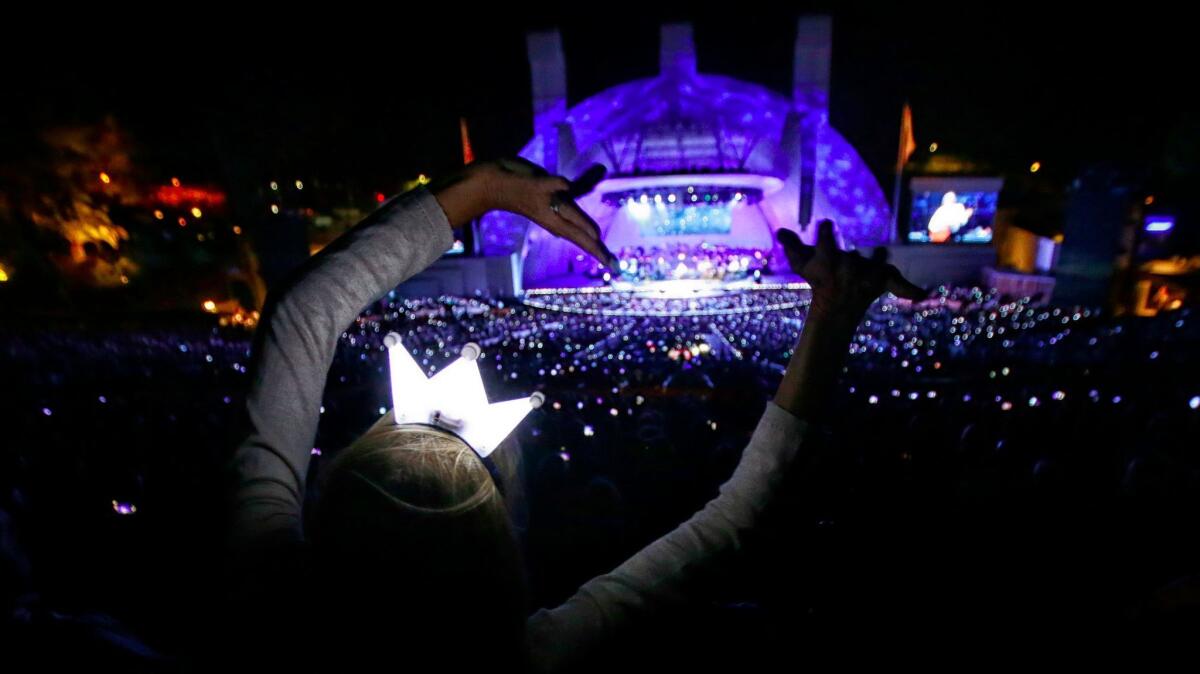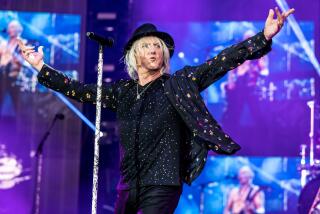The Moody Blues open the season — and flirt with self-parody — at the Hollywood Bowl

Justin Hayward wasn’t worried about showing his back to the audience.
Standing onstage Saturday night before a full house at the Hollywood Bowl, the Moody Blues’ frontman had just finished singing “The Morning: Another Morning” — a bouncy pop pastorale from the British band’s 1967 album “Days of Future Passed” — when he turned around and stayed that way for a minute or so, enthralled by the sound of the Hollywood Bowl Orchestra as it moved through the song’s lush instrumental coda.
At least he was enjoying himself.
In keeping with recent tradition at Los Angeles’ most iconic venue, Saturday’s opening-night concert paired the formally attired orchestra (under the direction of conductor Thomas Wilkins) with a veteran classic-rock act to kick off the Bowl’s summer season.
Last year the act was Steely Dan; the year before that, it was Journey. You can see why someone thought the Moody Blues would make a good fit, but that person was woefully mistaken.
Featuring three members from the band’s late-’60s heyday — singer-guitarist Hayward, bassist John Lodge and drummer Graeme Edge — the group is on tour this year celebrating the 50th anniversary of “Days of Future Passed.” The album included the hits “Tuesday Afternoon” and “Nights in White Satin,” and is widely regarded as a landmark in the development of progressive rock.

The way the band tells it, the Moody Blues — initially one of countless young English groups aping American R&B — were asked by its record company to come up with an LP combining rock and classical elements that would show off the hi-fi possibilities of the company’s new record player.
What was created was an elaborate concept piece, complete with lengthy interludes and ponderous spoken bits, tracking the progression of a single day into night. “Days of Future Passed” made stars of the dreamy-eyed Hayward and his mates, and if the album never earned the acclaim of other totems of the Summer of Love — “Sgt. Pepper’s Lonely Hearts Club Band” springs to mind — it’s clear that it went on to inspire further explorations of symphonic rock by the likes of Electric Light Orchestra and Emerson, Lake & Palmer.
The members of the Moody Blues themselves stuck with that idea through the early ’70s before going more commercial in the ’80s (not unlike Yes and Genesis) with slick pop hits such as “Your Wildest Dreams” and “I Know You’re Out There Somewhere.”
At the Bowl, though, the main attraction was a full rendition of “Days of Future Passed,” which the band said it was performing for the first time with live orchestral accompaniment. (Elsewhere on its tour the group is playing along to pre-recorded arrangements.)
As Hayward’s reaction to “Another Morning” suggested, the sound was impressive — full-bodied but nimble, with a lively rhythmic energy that kept the strings from getting too soupy. In “Evening: The Sunset,” the orchestra added a touch of romantic mystery to the band’s spooky depiction of that moment, “when the sun goes down and the clouds all frown.”
No wonder Hayward swiveled his body several more times throughout the night to take in what Wilkins and his players were doing. This was probably the closest the Moody Blues have come to their experience recording “Days of Future Passed” with the London Festival Orchestra half a century ago.

Yet most of the album’s songs have not aged well, especially the ersatz psychedelia of “Tuesday Afternoon,” which felt far cornier than other willfully trippy visions from its era. “I’m looking at myself / Reflections of my mind,” Hayward sang, “It’s just the kind of day to leave myself behind.”
Yikes.
Cheap-looking visuals on the Bowl’s large screens didn’t help the music seem any less dated. It actively took away from one’s ability to enjoy the sumptuous sonics of “Another Morning.”
For a group of men in their 70s who performed hunched over their instruments, a video of balloons and little kids at play was probably a sadder, more jarring image than the band intended.
There was also the band’s lack of chemistry. Trading off vocals, Hayward and Lodge barely interacted onstage; behind them, Edge looked like he was merely pretending to play drums while the group’s hired-hand drummer, Billy Ashbaugh, did the actual job of driving the music.
A sense of real-time spontaneity might’ve prevented the concert from feeling as overblown as it did. That quality certainly did wonders last year for Steely Dan, whose members spoke to each other (and to the crowd) in a manner that made them appear in on the joke of their own grandiosity.
Not that we should’ve expected laughs from a band with a song called “Isn’t Life Strange,” to name one of several leaden ditties the Moody Blues played from albums other than “Days of Future Passed.”
Self-seriousness is one thing. Quite another is the self-parody this group flirted with by having the actor Jeremy Irons show up in yet another video to deliver those painful spoken passages from 1967.
“Coldhearted orb that rules the night removes the colors from our sight,” Irons intoned in one laughably pretentious sequence. “Red is gray and yellow white, but we decide which is right — and which is an illusion.”
It was bad enough to make you hope the Hollywood Bowl looks somewhere beyond classic rock for next year’s opening night.
Unless Spinal Tap wants the gig.
That could work out OK.
Twitter: @mikaelwood
ALSO
Roger Waters takes on President Trump with ‘Is This the Life We Really Want?’
What Chuck Berry’s and Glen Campbell’s final albums have to say about the end of the road
A professor and a comedian: Maestro Thomas Wilkins on why funny works at the Hollywood Bowl
Steely Dan with strings at the Hollywood Bowl? ‘For some reason we decided we were gonna do this’
More to Read
The biggest entertainment stories
Get our big stories about Hollywood, film, television, music, arts, culture and more right in your inbox as soon as they publish.
You may occasionally receive promotional content from the Los Angeles Times.











